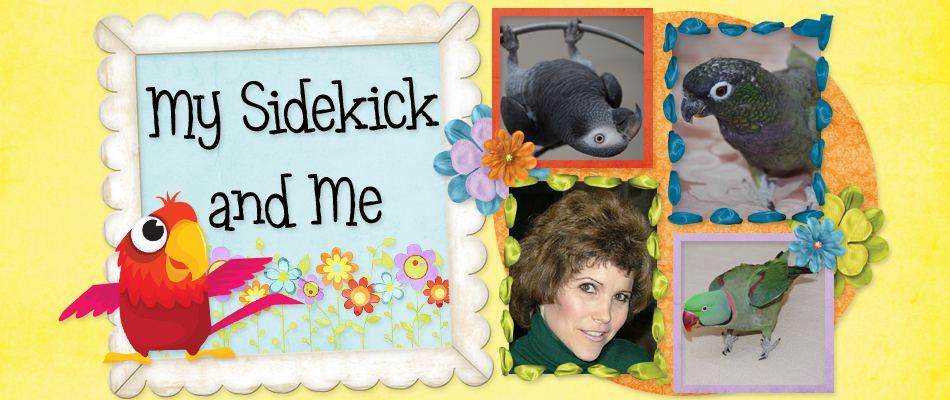 Written by Dr. Susan Friedman, Utah State University
Written by Dr. Susan Friedman, Utah State University
(Susan has taught me and thousands of others around the world about applied behavioral analysis, how it can strengthen our relationship with our pets, and how it can open the floodgates for learning among all living creatures.)
To improve our ability to understand and influence our parrots’ behavior, we need a systematic approach which provides an organized framework and simplifies the seeming complexity that threatens to obscure our view.
As Simple as ABC
One such approach to understanding specific behaviors is known as ABC analysis. The letters stand for the three elements of a simplified behavioral “equation” which includes the antecedents, behavior, and consequences. With this strategy, we seek to identify through careful observation the events and conditions that occur before the target behavior − antecedents, as well as identifying the results that follow the behavior - consequences. This simple analysis, when paired with keen observation skills and creative problem-solving, will help us clarify the way in which the basic components of behavior are interrelated. It is this clarity that leads us to important insights and teaching strategies.
How To
There are six steps to analyzing the ABCs: (1) describe the target behavior in clear, observable terms; (2) describe the antecedent events that occur and conditions that exist immediately before the behavior happens; (3) describe the consequences that immediately follow the behavior; (4) examine the antecedents, the behavior and the consequence in sequence; (5) devise new antecedents and/or consequences to teach new behaviors or change existing ones; (6) evaluate the outcome.
Let’s look at one example: Veda, my otherwise charming Alexandrine Parakeet bites fast and forcefully when I ask her to step onto my hand from inside her cage. Seeing the problem in isolation and decked-out in its full complexity, we might hypothesize that she is aggressive, territorial, hormonal, defensive, or dominating. Alternatively, she could be recalcitrant, stubborn, uncooperative or simply a stinker who is also spoiled rotten! Any one, or all, of these hypotheses might be accurate, but in terms of problem-solving, they serve only to label the behavior, not resolve it. And, since they do not describe observable behaviors per se, one can never really be sure about the accuracy of the label.
The ABC Analysis
What follows is my analysis of Veda’s biting behavior using the ABC approach: First, the background and setting: When asked to step onto my hand from inside her cage, Veda often, but not always, bites me! She does not bite under any other circumstance or in any other situation. She does it any time of day and with all her family members. However, once out of her cage, Veda steps up and down without hesitation, from all locations, including the top of her cage. For three or four hours each day, Veda plays happily on her tree perch in the family room, enjoys cuddles, and generally relaxes by preening, playing with toys and nibbling. She is by all other measures an outstanding companion bird.
Step 1: Describe the behavior in observable terms.
Veda widens her eyes, tightens her grip on her perch, pulls her body back and waits in this position for a second or two. If I don’t move my hand she bites it hard.
Step 2: Describe the antecedents.
Any time I walk up to Veda’s cage, I greet her to let her know I’m there. I open her cage door, slowly put my hand in front of her and say, “Step up, Veda.”
Step 3: Describe the consequences.
I remove my bitten hand (hurt and annoyed), and Veda stays in her cage. Case, or should I say door, closed.
Step 4: Examine the antecedents, the behavior, and the consequences in sequence.
Any time I walk up to Veda’s cage, I greet her to let her know I’m there; I open her cage door, slowly put my hand in front of her and say, “Step up, Veda.” Veda widens her eyes, tightens her grip on her perch, pulls her body back and waits in this position for a second or two. If I don’t move my hand, she bites it hard. I remove my bitten hand (hurt and annoyed), and Veda stays in her cage.
Let’s stop here for a minute to examine the insights that resulted from this analysis, as it helped me clarify several important things. First, far from being a biter or having a biting problem in any chronic or generalized sense, I learned that Veda displays a very specific set of responses, in a specific location with a different antecedent than I had originally assumed. Before analyzing the ABCs of Veda’s biting behavior, I had not realized that she tenses her body, pulls away from her perch and widens her eyes in a valiant attempt to warn me to withdraw. How remarkable!
In this light, it becomes so clear that the critical antecedent to her biting is not my putting my hand in her cage; it’s ignoring her non-aggressive communication, requesting me to remove it. Only when I ignore her communication and persist does she resort to biting. So, who set the silver balls in motion this time, Veda or me?
It is also evident that by withdrawing my hand and leaving her in her cage, I was in fact, reinforcing the biting. With each of these interactions, I was unwittingly, but explicitly, teaching Veda that biting is an effective and necessary way to get my hand out of her cage; apparently so, since warning me non-aggressively did not work. I’m sure she would say it was nothing personal but that I was quite … dense! Can’t you just hear her explaining this to our baby cockatoo? “Listen up, baby. No matter how kind and gentle you want to be, these humans respond to one thing and one thing only, aggression. Why, it’s a jungle in here!”
Step 5: Devise new antecedents and/or consequences.
After careful consideration of my options, in this case I chose to change the antecedents to decrease Veda’s biting. First, I no longer say, “Step up!” when I want her to come out of her cage. Instead I ask her, “Wanna step up?” If she displays the warning behaviors, I take that as an unqualified “No, but thanks for asking!” and I calmly remove my hand from her cage. I then leave her cage door open, allowing her to exit how and when she chooses. As an additional strategy, I trained her to step onto a perching stick for those rare times when staying in her cage is not an option. We practice stepping onto the stick a few times a week, for which she earns an avalanche of praise and kisses.
Step 6: Evaluate the outcome.
Changing the antecedents to decrease Veda’s biting has been a huge success. Of course it is not surprising that she no longer bites me – by heeding her warnings, I don’t give her the opportunity, or the reason, to do so. I continue to present my hand to her and ask if she wants to step up. If she tenses her stance, pulls away and/or widens her eyes I remove my hand and go on to other things (you know, like cleaning cages and changing water bowls, uh-huh).
What has been very unexpected is that after a few months of letting her decide how to come out of her cage, she now rarely declines my offer to take her out on my hand, choosing instead to step up nicely and hitch a ride! Who knows … maybe the freedom of choice was important to her or she benefited from more control over her own destiny; perhaps her trust level increased when I lowered my apparent dominance. These are all very interesting possibilities.
Closing Thoughts
In my opinion, we generally focus too much on consequences to influence behavior. This is especially true of negative behaviors that we want to decrease or eliminate. In this way, we limit ourselves to rewarding or punishing more or less. One of the exciting benefits of this simple analysis strategy is that it fosters careful consideration of the antecedents, that is, the things we do to promote … or provoke … behavior. Antecedents should be brilliantly arranged to ensure that the appropriate behavior is facilitated. Doing so makes selecting consequences easy – when the behaviors are all acceptable, the consequences are all positive! I truly believe (and my experience working children bears this out) behind every negative behavior is a poorly arranged antecedent.
There is certainly more than one way to productively analyze a behavior sequence and more than one useful solution to be devised. The right analysis and solution is the one that produces the desired outcome, fits the style in which you and your bird are comfortable interacting and improves your relationship with your bird. With Veda, all three criteria were met. In our teaching, we are limited only by our powers of observation, our creativity and our resolve to treat our parrots humanely and with compassion.
This original version of this article is reprinted with permission from the TGPC Internet Conference, December 2000.
Monday, May 25, 2009
Understanding Behavior Is As Simple As ABC
Subscribe to:
Post Comments (Atom)












0 comments:
Post a Comment